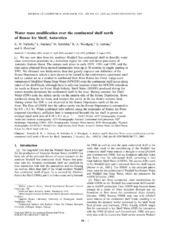| dc.contributor.author | Nicholls, Keith W. | eng |
| dc.contributor.author | Padman, L. | eng |
| dc.contributor.author | Schröder, Michael | eng |
| dc.contributor.author | Woodgate, R. A. | eng |
| dc.contributor.author | Jenkins, Adrian | eng |
| dc.contributor.author | Østerhus, Svein | eng |
| dc.date.accessioned | 2004-08-10T12:44:07Z | en_US |
| dc.date.accessioned | 2004-08-26T11:57:31Z | |
| dc.date.available | 2004-08-10T12:44:07Z | en_US |
| dc.date.available | 2004-08-26T11:57:31Z | |
| dc.date.issued | 2003-08-13 | eng |
| dc.Published | Journal of Geophysical Research - Oceans 108(C8): 3260 | en_US |
| dc.identifier.issn | 0148-0227 | en_US |
| dc.identifier.issn | 2156-2202 | en_US |
| dc.identifier.uri | https://hdl.handle.net/1956/371 | |
| dc.description.abstract | We use new data from the southern Weddell Sea continental shelf to describe water mass conversion processes in a formation region for cold and dense precursors of Antarctic Bottom Water. The cruises took place in early 1995, 1998, and 1999, and the time series obtained from moored instruments were up to 30 months in length, starting in 1995. We obtained new bathymetric data that greatly improve our definition of the Ronne Depression, which is now shown to be limited to the southwestern continental shelf and so cannot act as a conduit to northward flow from Ronne Ice Front. Large-scale intrusions of Modified Warm Deep Water (MWDW) onto the continental shelf occur along much of the shelf break, although there is only one location where the MWDWextends as far south as Ronne Ice Front. High-Salinity Shelf Water (HSSW) produced during the winter months dominates the continental shelf in the west. During summer, Ice Shelf Water (ISW) exits the subice cavity on the eastern side of the Ronne Depression, flows northwest along the ice front, and reenters the cavity at the ice front’s western limit. During winter the ISW is not observed in the Ronne Depression north of the ice front. The flow of HSSW into the subice cavity via the Ronne Depression is estimated to be 0.9 ± 0.3 Sv. When combined with inflows along the remainder of Ronne Ice Front (reported elsewhere), sufficient heat is transported beneath the ice shelf to power an average basal melt rate of 0.34 ± 0.1 m yr1. | en_US |
| dc.format.extent | 55772 bytes | eng |
| dc.format.extent | 137 bytes | eng |
| dc.format.extent | 2215249 bytes | eng |
| dc.format.mimetype | text/plain | eng |
| dc.format.mimetype | text/plain | eng |
| dc.format.mimetype | application/pdf | eng |
| dc.language.iso | eng | eng |
| dc.publisher | American Geophysical Union | en_US |
| dc.title | Water mass modification over the continental shelf north of Ronne Ice Shelf, Antarctica | en_US |
| dc.type | Journal article | |
| dc.description.version | publishedVersion | en_US |
| dc.rights.holder | Copyright 2003 by the American Geophysical Union | en_US |
| dc.identifier.doi | https://doi.org/10.1029/2002jc001713 | |
| dc.identifier.cristin | 398956 | |
| dc.source.journal | Journal of Geophysical Research - Oceans | |
| dc.source.40 | 108 | |
| dc.source.14 | C8 | |
| dc.source.pagenumber | 3260- | |
